18 The Rock Cycle I: Magma and Igneous Rock
This section is a pre-review version.
Learning Outcomes
By the end of this section you should be able to:
- Define rocks and distinguish them from minerals
- Explain the ways that rock can melt within the Earth, and the types of magma produced
- Identify the most abundant types of igneous rock
- Recognize major types of volcano and volcanic hazards
What are rocks?
The outer parts of the Geosphere, on which we live, are made of naturally occurring mixtures of minerals, together with small amounts of non-mineral material (e.g. organic matter; glass). We call these mixtures rocks.
Rocks fall into categories based on how they are formed and what they are made of, but unlike minerals there are not always gaps in composition between different types of rock. Rocks are classified to satisfy scientific curiosity and convenience, but there are many gradational boundaries between rock types and borderline cases. A given rock may have more than one correct name.
Three broad categories of rock are recognized.
- Igneous: formed from molten magma
- Sedimentary: deposited on the surface of the Geosphere by the Atmosphere, Hydrosphere or Biosphere
- Metamorphic: Originally igneous or sedimentary rocks that have formed new mineral grains while solid, as a result or heat, pressure, and/or deformation.
There are borderline cases applies even at this top level in classification. For example, a sedimentary rock may have been slightly metamorphosed so that one geologist will treat it as sedimentary while another studies it as an example of metamorphism. A volcanic ash deposit may be slightly reworked by streams on a volcano so that it has both sedimentary and igneous features. A metamorphic rock may have been heated to the point where some of its minerals melted, but others remained solid. Therefore, even the seemingly simple question “is this rock igneous, sedimentary, or metamorphic?” may have more than one answer. In general, it’s much more important to understand how a rock formed than it is to apply a correct name.
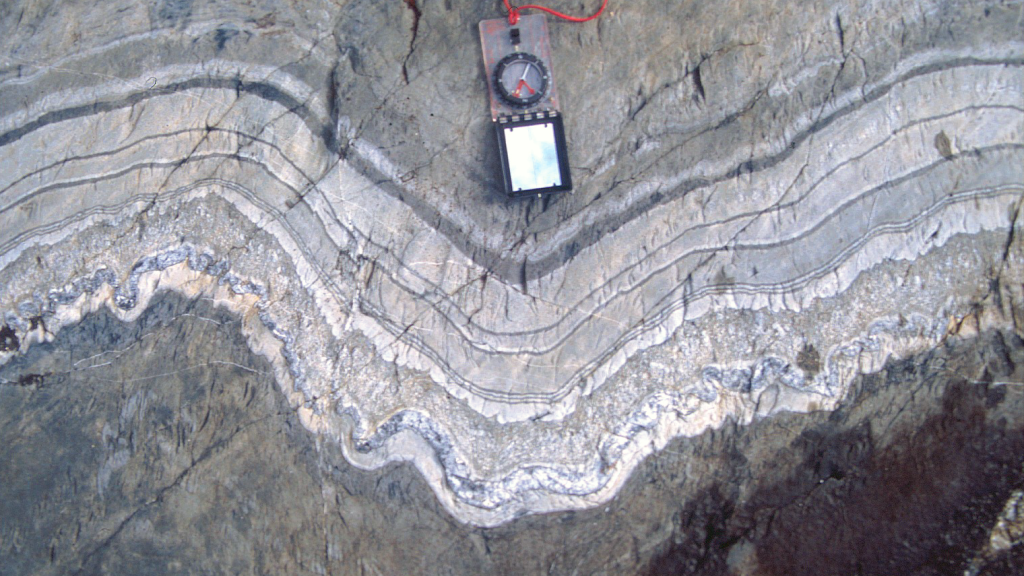
Magma

The term magma refers to any rock that has been sufficiently melted that it can flow as a liquid. There may be solid pieces within it, but it is essentially molten rock.
Lava is a special name for magma that reaches the surface.
When magma reaches the surface in explosive volcanic eruptions, the result may be a mass of small fragments, known as tephra.
How do rocks melt?
To understand how rocks melt we need to look Inside the Earth. Only two parts of the Earth are permanently liquid: the outer core and the hydrosphere. The rest of the Geosphere is essentially solid, so special circumstances are required to produce melting.
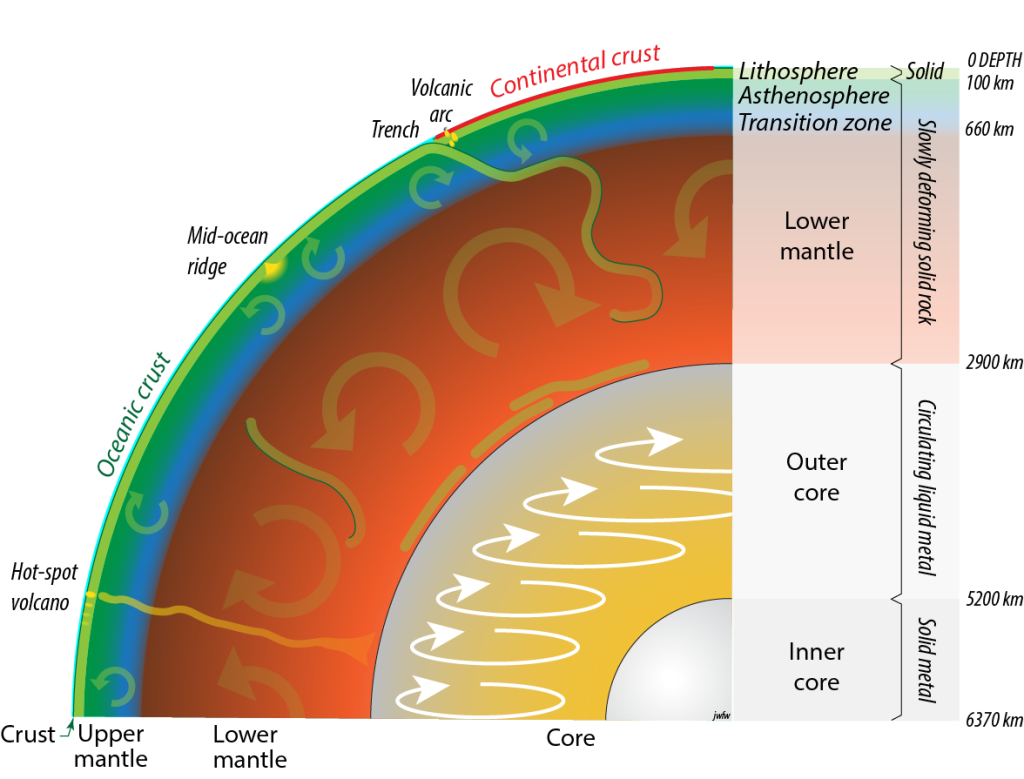
Many igneous rocks come from magma sourced from the Earth’s mantle, the vast bulk of the Earth that extends from about 2900 km below the surface to a few tens of kilometres beneath our feet. Although the mantle is mainly solid, and transmits seismic waves like an elastic solid, it is able to flow slowly over time. The best analogy for how it does this is silly putty. When deformed fast, for example by bouncing it on the floor, or by stretching it suddenly, silly putty behaves like an elastic solid, eventually snapping with a sharp break like rubber. However, if it’s deformed slowly, it flows like a liquid. Most of the Earth’s mantle behaves in these same two ways, but the mantle is about a trillion times stiffer (more viscous) than silly putty, so that flow of the whole mantle occurs at centimetres per year, not centimetres per second!
Melting in the mantle principally occurs two ways: First, the mantle can melt when rocks from depth move upwards adiabatically — that is, without losing or gaining significant heat energy. Second, melting can occur when water or other impurities are introduced by downward movement of crustal rocks into the mantle. To understand these processes we must look at the melting behaviour of silicate minerals.
Melting of single minerals
Single minerals melt at a fixed temperature (for a given pressure), but as pressure increases, the melting point typically increases too. These relationships can be shown on a simple phase diagram with axes representing pressure and temperature.
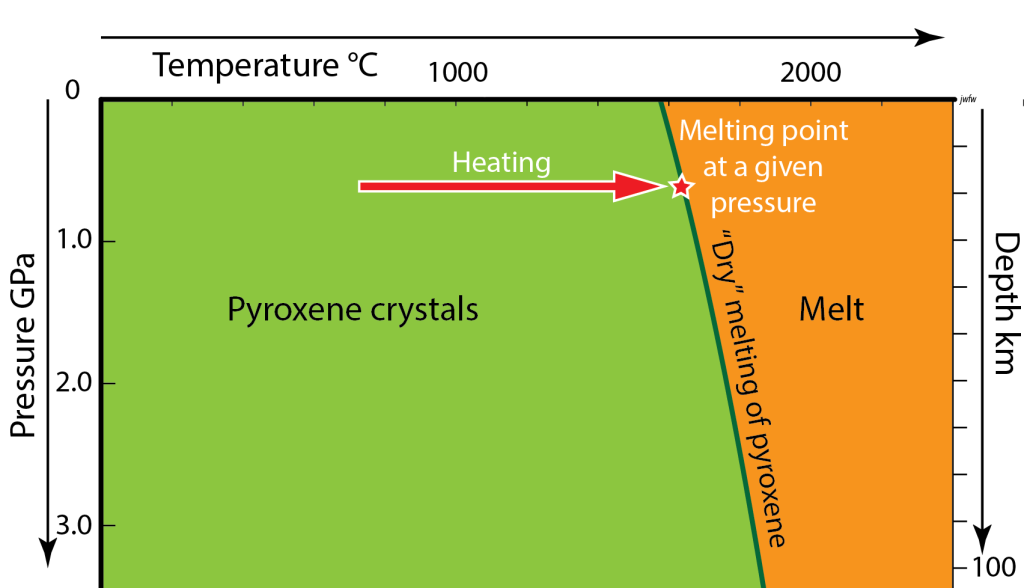
Notice that in the phase diagram, pressure is plotted so that it increases downwards. This is because pressure increases downward within the Earth at about 1 GPa every 35 km. For a common mineral (the diagram is for a ferromagnesian mineral that’s common in the upper mantle) it’s possible to distinguish two fields: a melt phase and a solid, crystalline phase, separated by a line called the melting curve. As the temperature of solid material increases, it eventually hits this line, where it will melt. The melting temperature increases with depth.
Next, imagine a crystal at depth, close to the melting point. If it rises adiabatically (without exchanging heat with its surroundings) its temperature remains roughly the same, but the pressure decreases. (Notice that this behaviour is quite different from adiabatic rise of air in the Atmosphere. Gases expand a great deal as the pressure is reduced, and do work on their surroundings; therefore their temperature falls. Solids and liquids do not expand much in response to falling pressure, and so their temperature doesn’t change much during adiabatic rise.)
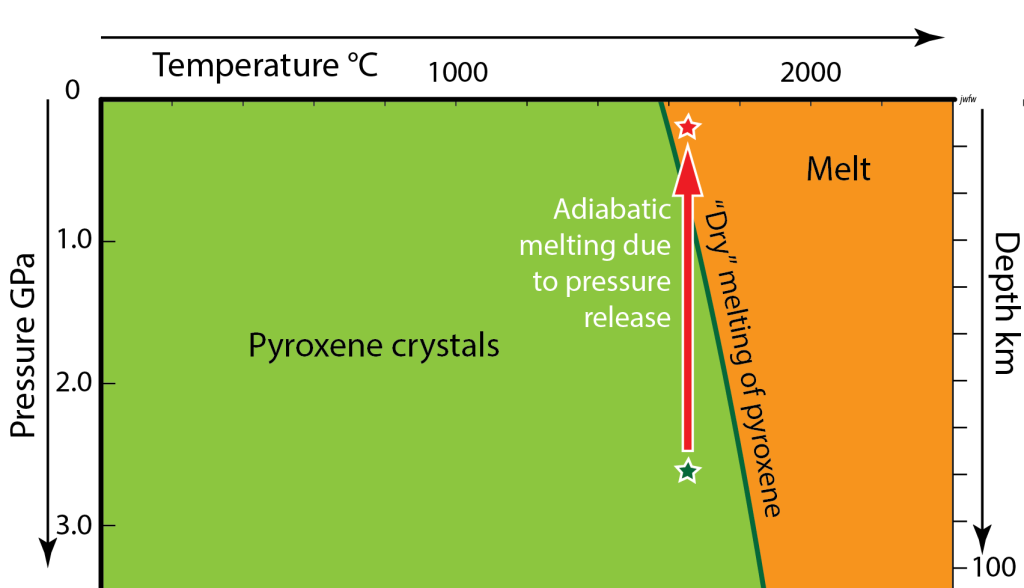
As a result, it’s possible for the mineral to intersect its melting curve simply as a result of the decrease in pressure, and this is an important process of melting in the mantle that gives rise to volcanoes like those of Hawai’i and Iceland.
If we add water to the system, things change. The second curve (below) represents the melting behaviour of a mixture of the ferromagnesian mineral and water. Notice that the field of melt is much larger. This is because water cannot dissolve in the mineral, but it does dissolve in the liquid phase if the pressure is high, making the liquid more stable. Hence it lowers the melting point.
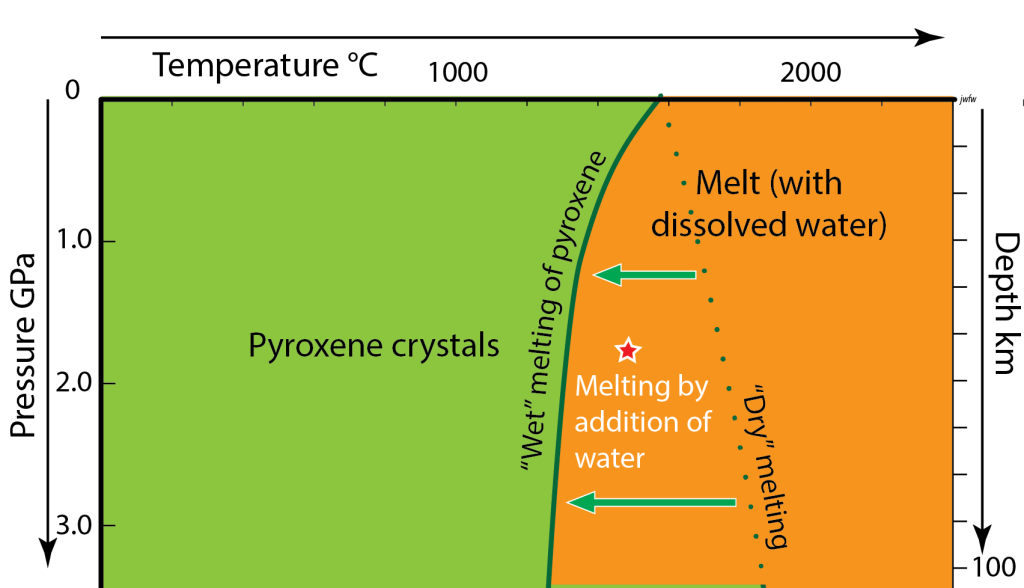
The effect is similar to that of adding salt to ice. The salt dissolves in the liquid phase, making it more stable, and the melting point is lowered.
So, a third way to melt our hypothetical mineral grain is to add water, so that it lies to the right of the melting curve in the diagram. This is the process that gives rise to volcanoes in the Pacific “ring of fire”, which lie above subduction zones — places where water-soaked rocks from the ocean floor are dragged downward within the mantle.
Notice that once the rock is saturated with water, raising it adiabatically doesn’t cause melting any more, because the gradient of the melting curve has changed. It slopes down to the left on the diagram, so that water-saturated melting is easier at greater depth. In fact, burying water-saturated rock may cause it to melt. However, burying a hot rock that contains water may cause melting.
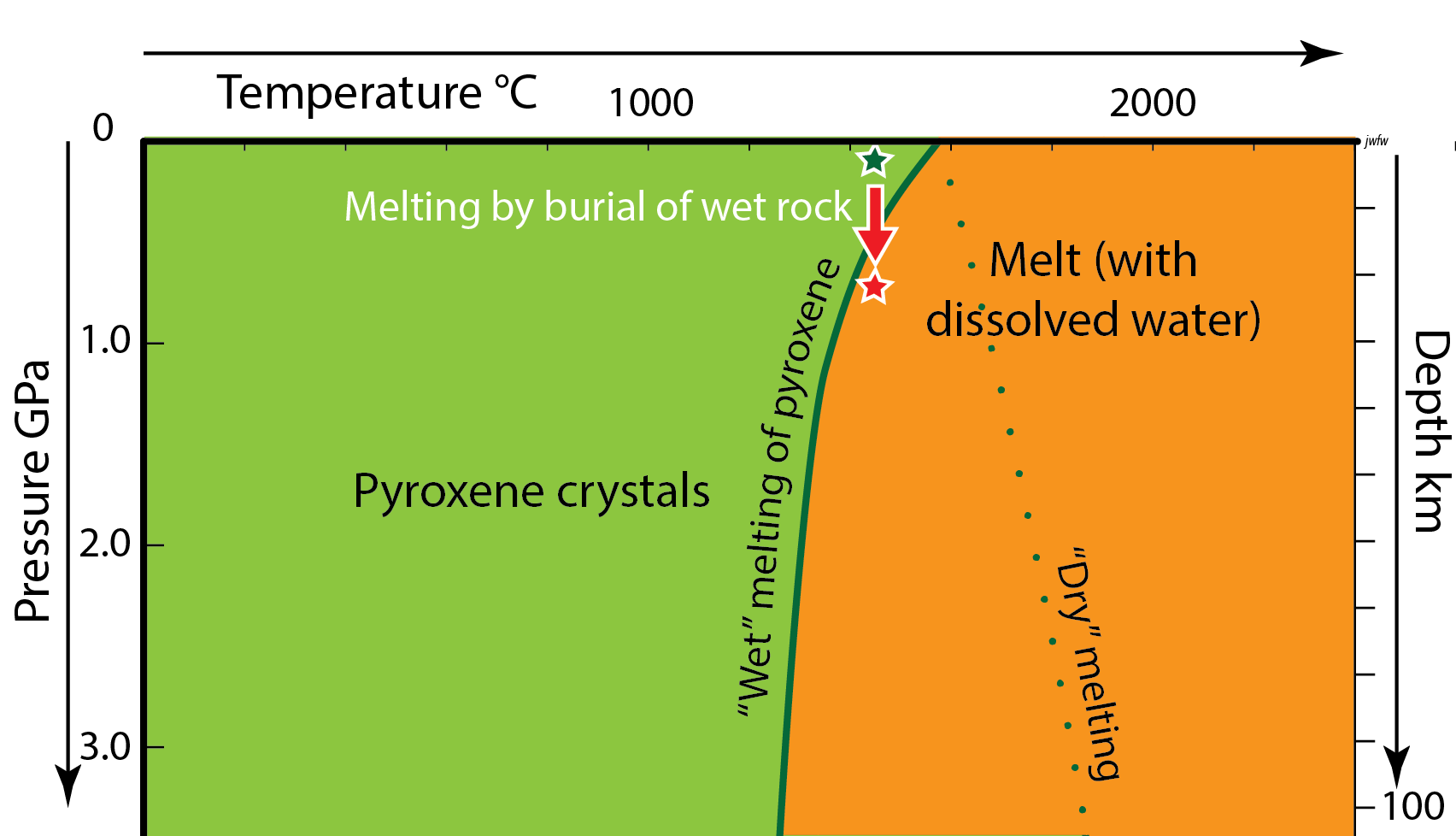
Overall, we can therefore recognize a four different processes that can cause melting within the Earth:
- Direct addition of heat (usually from hotter magma that has risen from below).
- Rise of dry solid rock so that the pressure decreases;
- Addition of water to solid rock that is already hot, which moves the melting curve to a lower temperature;
- Burial of water-saturated solid rock so that the pressure increases;
Although direct addition of heat is perhaps the most obvious way of melting a rock, it’s probably the least important of the four in terms of magma production within the Earth.
Melting a mixture
Minerals all have different melting temperatures. Mixtures of minerals therefore melt over a range of temperatures, instead of having a fixed melting point. If we draw a phase diagram for a mixture, we need to draw two melting curves.
- The solidus marks the start of melting
- The liquidus marks the completion of melting at which point the mixture is entirely liquid.
Between these limits the rock is partially molten: a slurry of magma and crystals.
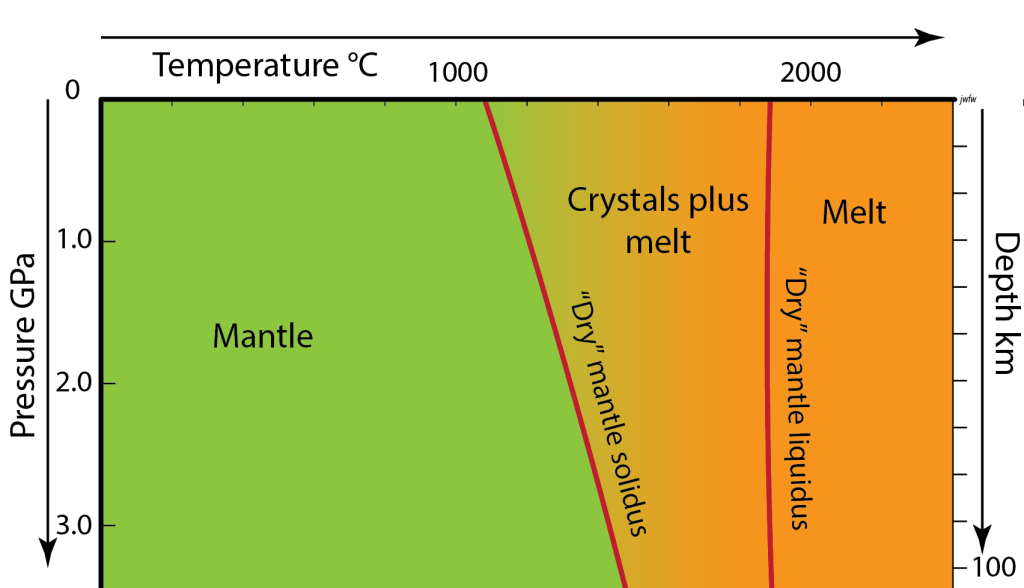
The solidus of a mixture may occur at a lower temperature than any of the pure minerals. We can see this effect when using road salt too. If we make a mixture of ice and halite (two minerals, forming an artificial rock) it starts to melt at a lower temperature (-21°C) than either water (0°C) or halite (801°C). Similarly a mixture like the mantle (which typically contains olivine, and several other ferromagnesian minerals in smaller amounts) may start to melt at a lower temperature than any of the constituent minerals.

If water is added under pressure, the temperature required for melting becomes even lower.
Another important feature of partial melting is that it typically produces a magma with different composition from the parent rock. In general, the mineral with the lowest melting point will make the largest contribution to the magma, while the mineral with the highest melting point remains mostly solid for the longest time. The melt would only reach the composition of the original rock at the liquidus temperature, where the solid rock is entirely melted.
Of the common minerals in the mantle, olivine, with abundant iron and magnesium and lower silica content, is the mineral that has the highest melting point, so it makes the smallest contribution to the magma. Other ferro-magnesian minerals, containing more silica, together with appreciable amounts of calcium, aluminum, sodium and potassium, have lower melting points and contribute more to the magma. Because of this process, magma formed by partial melting in the mantle is richer in silica and poorer in iron and magnesium than the mantle from which it came. Operating over billions of years, this is the process that has given the Earth a crust that is very different from the underlying mantle.
To sum up, we can make the following generalizations about melting of natural mixtures such as rocks
- Melting of a mixture begins at a temperature lower than the melting points of the individual minerals;
- Partial melting is common for mixtures, and produces magma that has a different composition from the parent rock; the magma is enriched in the more easily melted parts of the solid.
What kinds of magma are there?
Magma is typically a disordered mixture of loosely linked silicate tetrahedra, other ions, and groups of atoms. Typically, the electrons lost by metals are accepted by one main element: oxygen, which is the most abundant element in igneous rocks, and the only major element which readily accepts electrons.
When chemists first learned to analyze igneous rocks, they would melt them down and carry out multiple chemical reactions. They would end up with solid oxides of all the different metals and weigh them precisely. Because oxygen is the main electron acceptor, the weights of these oxides effectively expressed the overall composition of the rock. Although igneous rocks are not typically analysed by these “wet chemical” methods any more[1], this method of expressing the composition has stuck around, so igneous petrologists are in the habit of expressing and comparing rock compositions in terms of the weights of oxides, which have become important in rock classification.
| SiO2 | 73.9% |
| Al2O3 | 14.3% |
| Fe2O3 | 1.5% |
| MgO | 0.8% |
| CaO | 0.4% |
| Na2O | 3.5% |
| K2O | 4.5% |
Silica (SiO2) is the most abundant component of almost all magma and igneous rocks and is typically the first thing we look at when classifying igneous rocks. This is also convenient when looking at hand samples because most of the minerals that contain lots of silica (quartz, feldspar, white mica) are pale in colour, whereas those with lower amounts of silica (mainly ferromagnesian minerals) are dark. Hence it’s possible to make a first guess about the amount of silica in a rock from the overall colour of its minerals. The typical range is from below 45% silica to over 75% silica, so the granite example analysed in the table, with 73.5% silica, formed from a magma that was relatively rich in silica.
Based on the amount of silica, magmas and igneous rocks are classified into four categories (shown here in colours similar to those of typical rocks):
- Felsic. >65% silica.
- Intermediate. 52–65% silica.
- Mafic. 45–52% silica.
- Ultramafic. <45% silica.
Igneous rocks and volcanoes
Grain-size of igneous rocks
Silicate magma is almost always less dense than the rock from which it was produced, so once magma is formed, it typically rises toward the Earth’s surface. If it reaches the Earth’s surface, it produces volcanoes. However, we know that a great deal of magma never makes it to the surface, but cools down within the Earth’s crust, solidifying to produce igneous intrusions.
When magma cools down, it usually crystallizes into an interlocking mass of mineral grains. Depending on how fast the magma cools, those grains may be small or large.

When magma is erupted onto the Earth’s surface as lava, it cools and solidifies rapidly to form extrusive or volcanic rock. There is not much time for ions to move through the cooling liquid to the growing minerals, so the mineral grains that form are very small (typically well under a millimetre). In many volcanic rocks the mineral grains can only be seen with a lens or under a microscope. In extreme cases, lava cools so fast that it completely fails to form mineral crystals. Instead it solidifies with the same chaotic atomic structure that characterizes liquids, forming natural volcanic glass.
In other cases, dissolved gases come out of solution in erupting lava, causing explosions that produce a mass of fragments called tephra. (Volcanic ash is fine-grained tephra.). These textures indicate that the igneous rock is volcanic or extrusive — it was formed by erupted lava at the Earth’s surface.
In contrast, large amounts of magma that have formed in the Earth’s past never made it to the surface. Magma cooled down slowly within the crust, forming bodies of solidified magma called igneous intrusions. Large intrusions may be several hundred kilometres across. How do we know about them? Many igneous intrusions have been revealed at the Earth’s surface by the erosion of the overlying rocks.
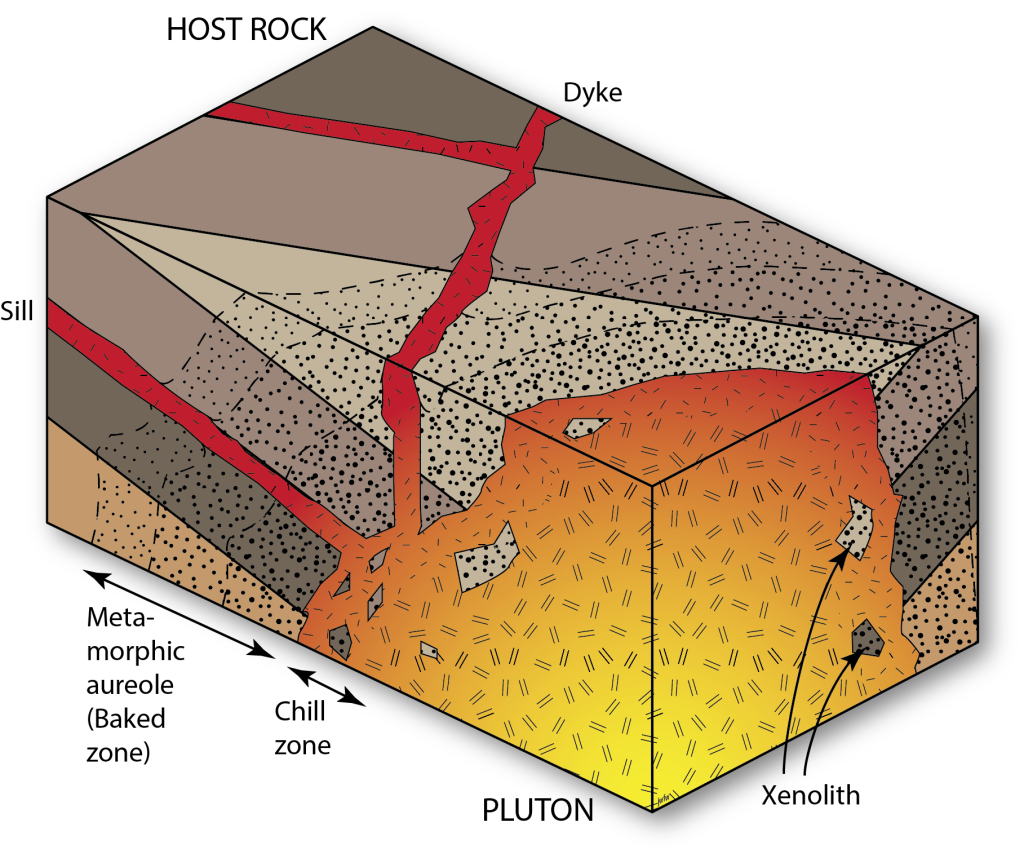
Intrusions come in many shapes and sizes. Irregular blob-shaped masses of intrusive rock are called plutons. If they are large (over 40 km2) they are referred to as batholiths. Around large intrusions, it’s common for magma to work its way into cracks in the surrounding rock, where it solidifies to form sheet-like smaller intrusions. These are called sills if they are concordant with layers in the surrounding rock, and dykes [2] if they are discordant, cutting across structures in the surrounding rocks.
Large intrusions cool down very slowly (over hundreds of thousands or even millions of years). As a result of this long, slow cooling, the mineral grains in intrusive igneous rocks are typically large interlocking crystals from a millimetre to a few centimetres across. If the magma was intruded into cold surrounding host rocks, it’s common to find a finer-grained chilled margin, where the magma was rapidly cooled at the edge of the intrusion. In places, pieces of the host rock may break off. Where recognizable in an intrusion, these chunks of host rock are called xenoliths (pronounced “zenoliths”; from Greek words meaning “foreign rock”.)
Diversity of igneous rocks
In general, igneous rocks display mineral grains that interlock with one another to form a dense mass with low porosity. However, rocks formed from tephra are different. The particles produced by an explosive eruption may rest against one another, without interlocking, looking more like a sedimentary rock. Indeed, tephra may be reworked by water, wind or ice to produce sedimentary rock, so it’s possible to find rocks that are intermediate in character between igneous and sedimentary.
In general, igneous rocks are classified based on two criteria: their chemical composition, particularly the amount of silica, and their texture, particularly their grain-size. We will look at felsic, intermediate, mafic, and ultramafic examples.
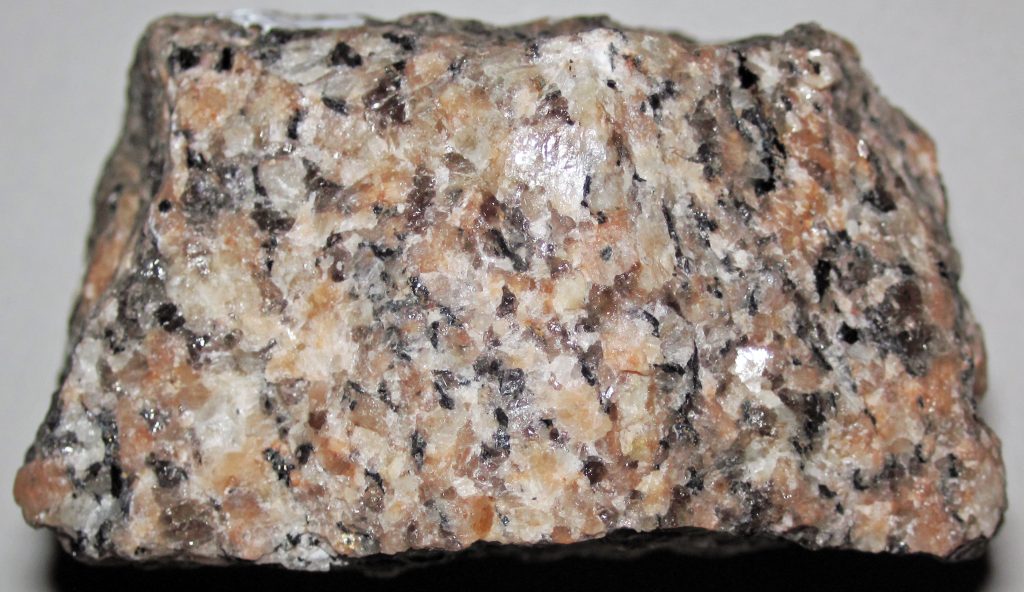
Felsic
Felsic magmas are those with more than 65% silica. Because the silicon and oxygen atoms in a silica-rich magma start to join up into chains and sheets even while the magma is liquid, silica-rich magmas are very viscous liquids – much stiffer than toothpaste. These magmas solidify at temperatures which are relatively low, however, typically 600-900°C.
Most silica-rich magma is generated by melting within the Earth’s crust. This can occur when wet sedimentary rocks are placed under pressure and heated up during the building of mountains as plates converge, or when hotter, mafic magma rises into the crust from the mantle below.
Rocks formed from high-silica magma tend to have (as you would expect) lots of quartz and other high-silica minerals such as potassium and sodium feldspar. (The word felsic is coined from ‘feldspar’ and ‘silica’.) Therefore, they tend to be pale in colour.
Intrusions of felsic magma crystallize to a mixture of quartz, feldspar, and (typically) mica, forming the most common intrusive rock in the continental crust, granite.
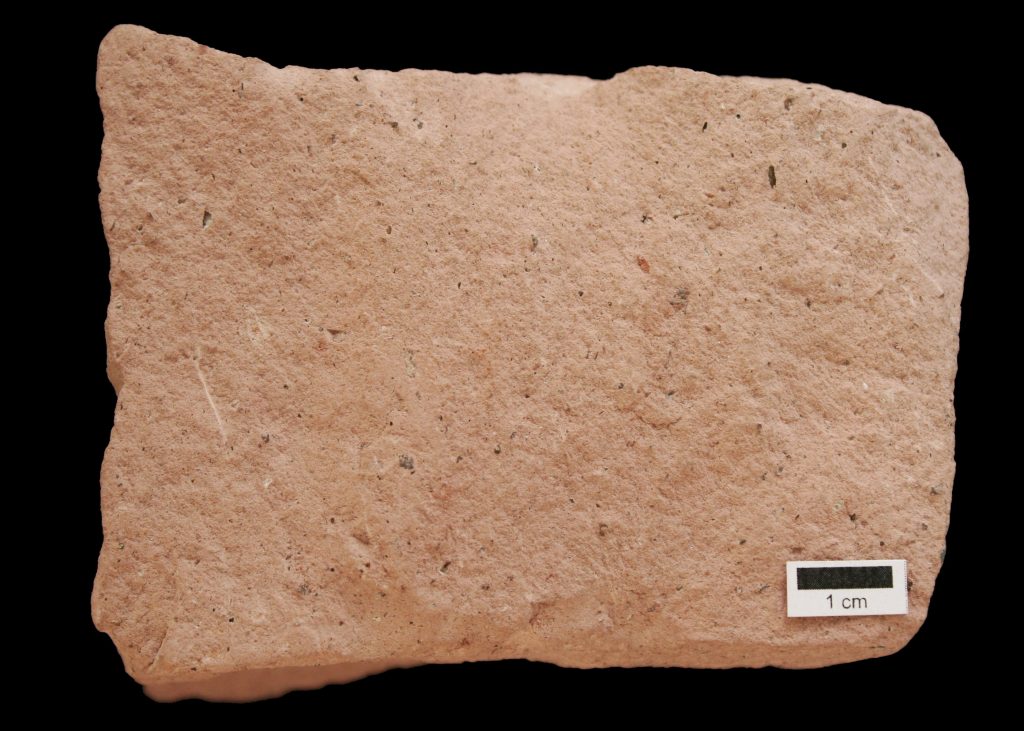
When extruded as lava, felsic magma crystallizes to a very hard, fine-grained rock called rhyolite. Although rhyolite is sometimes pale, like granite, it ranges in colour to deep reds, browns, and even greens. However, rhyolite can be distinguished from other fine grained, extrusive rocks by its hardness, which derives from the presence of tightly interlocked, microscopic quartz and feldspar grains.
Intermediate
Intermediate igneous rocks, with between 52% and 65% silica, are typical of regions where water gets into the mantle as a result of subduction — the movement of one plate under another where plates converge.
When intermediate magma crystallizes, the silica is all used up making feldspar and ferro-magnesian minerals. The resulting rock therefore contains no quartz, but is otherwise similar to felsic rocks, typically with abundant sodium feldspar, and smaller amounts of smaller amounts of ferro-magnesian minerals. A typical intrusive intermediate rock is diorite. Its extrusive equivalent is andesite — named for the Andes mountains along the west coast of South America, beneath which subduction of the Pacific ocean floor is taking place and water is introduced into the mantle, causing partial melting.
Intermediate rocks are typically intermediate in colour: speckled grey and brown colours are common.
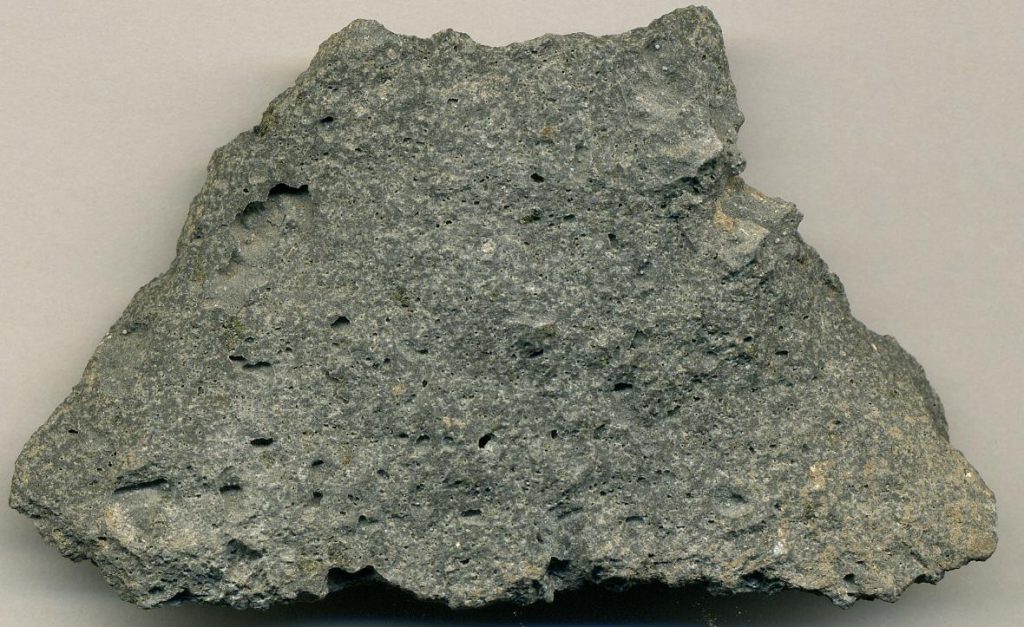
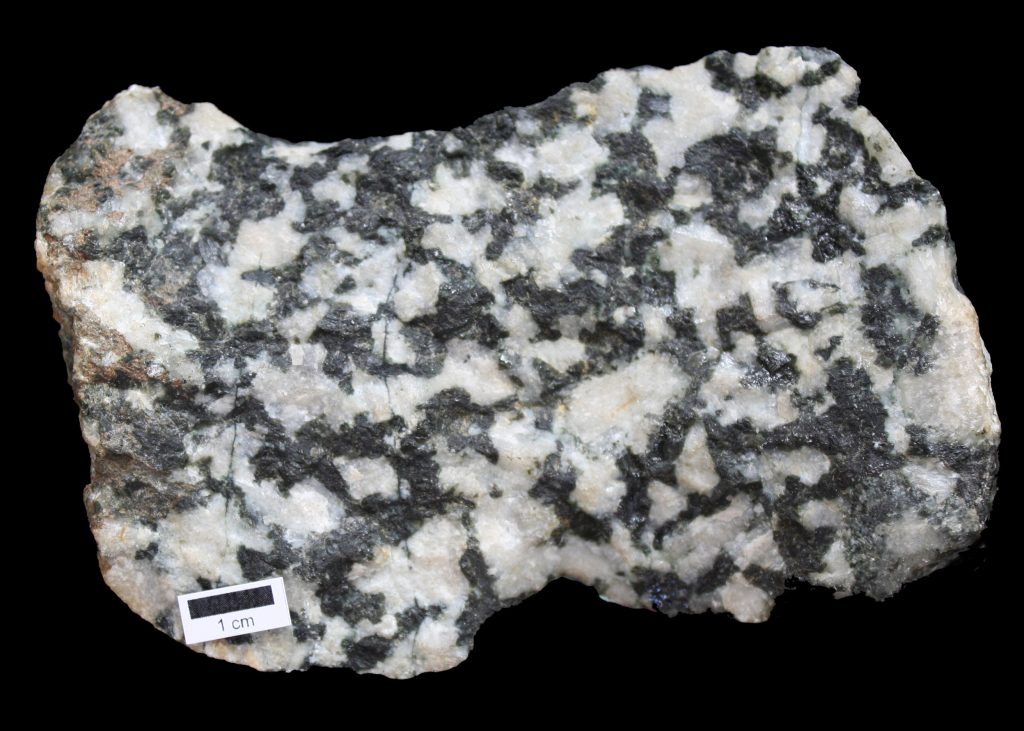
Mafic
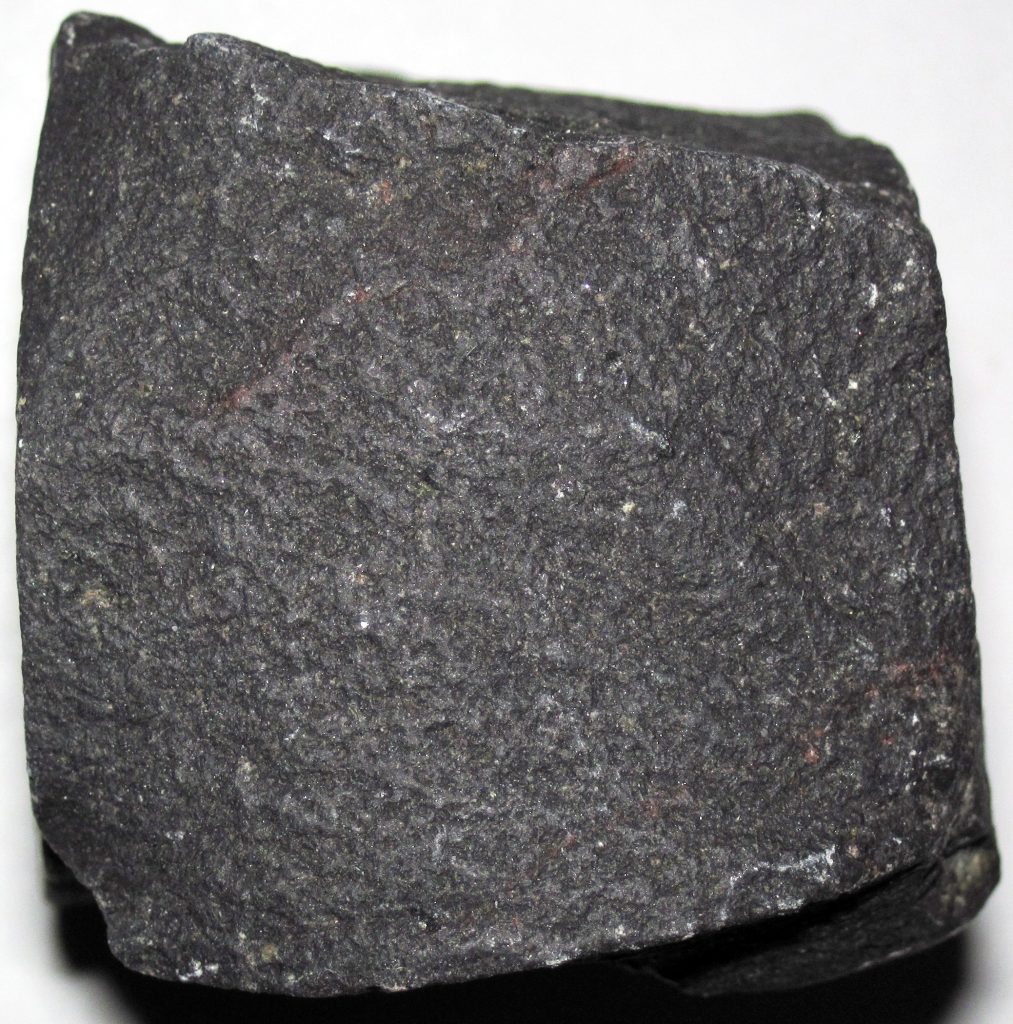
Towards the other end of the range is magma with only 45 to 50% silica, described as mafic (a word derived from magnesium and Fe, for iron). Most mafic magma is produced by partial melting of the Earth’s mantle.
In most cases, these magmas have large amounts of MgO and FeO in their analyses. Because of the smaller percentage of silica, the magma has very low viscosity — it flows over long distances when it reaches the surface as lava.
Mafic magma solidifies at high temperature (above 1000°C). It produces abundant ferromagnesian minerals and feldspar (typically calcium-rich), but no quartz.
Rocks formed from low-silica magma are typically dark in colour because of all the ferromagnesian minerals. Mafic lava is called basalt. It’s typically black, and very fine grained. Basalt is an extremely abundant rock, as it forms the uppermost layer of crust beneath most of the ocean basins.
The extrusive equivalent of basalt is gabbro. On freshly broken surfaces, gabbro is also dark in colour due to the presence of ferromagnesian minerals like pyroxene and sometimes olivine, together with grey calcium feldspar. On weathered surfaces the feldspar may appears white (due to the formation of fine clay minerals) so gabbro often has a speckled appearance in weathered rock outcrops.
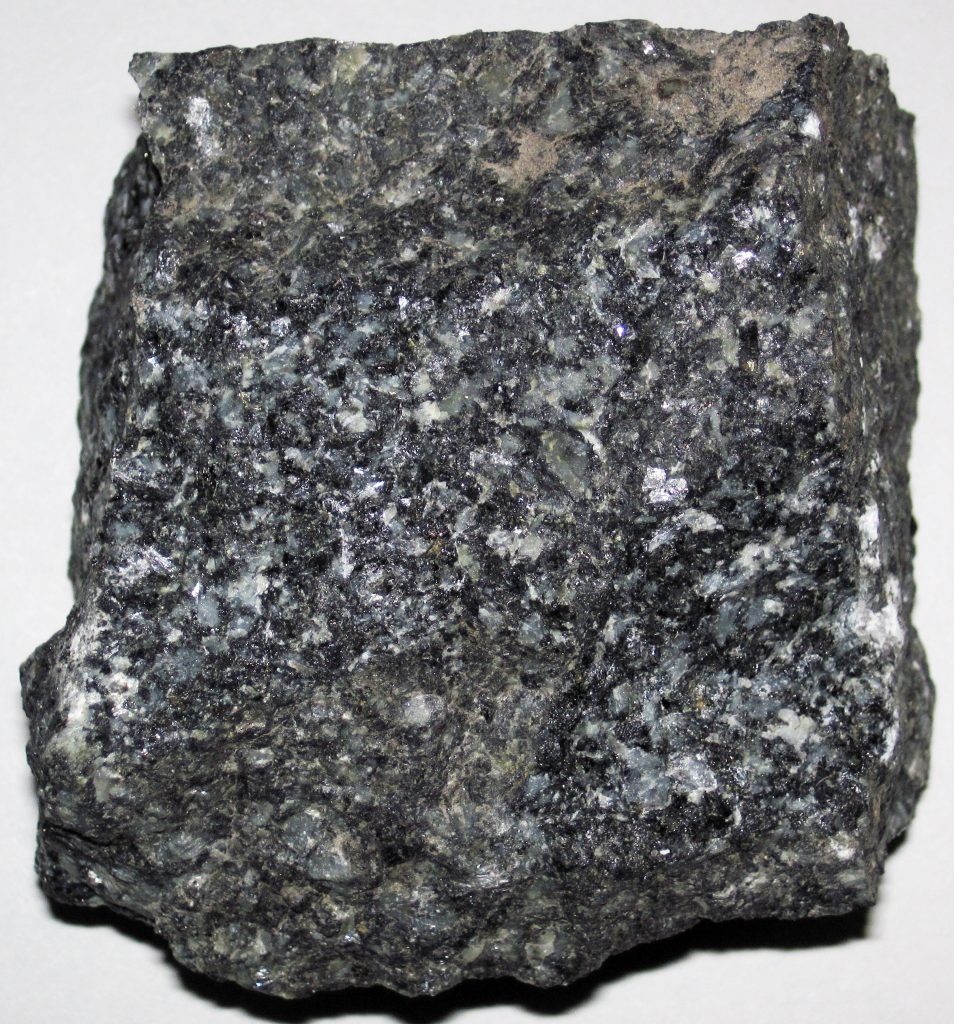
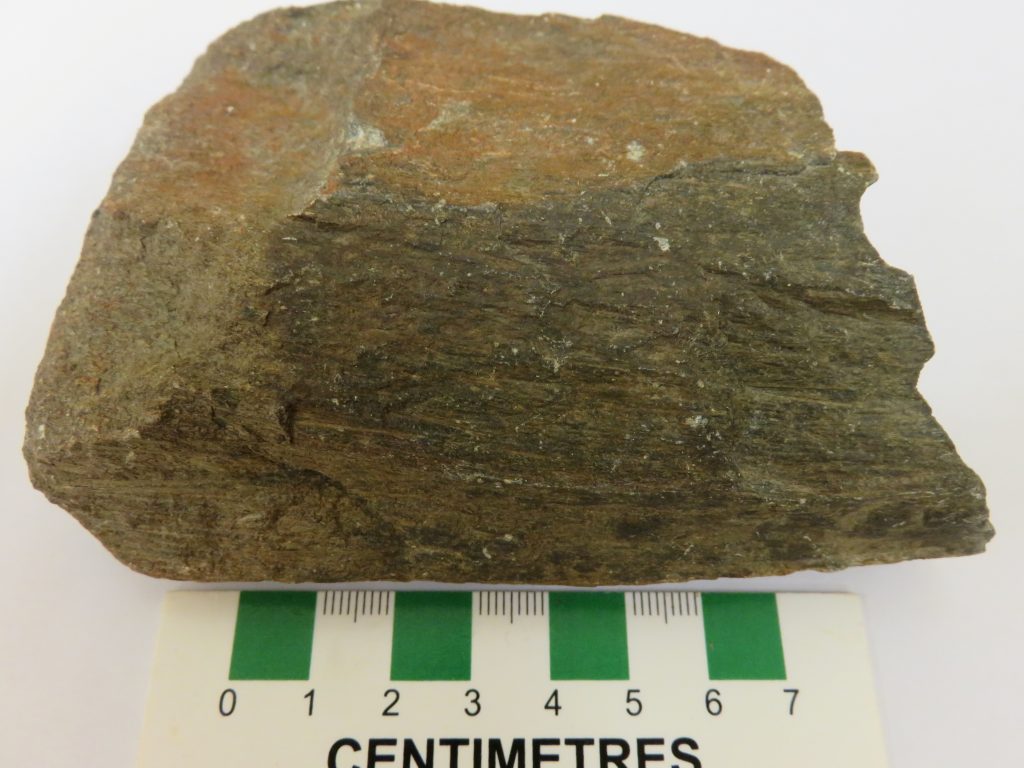
Ultramafic
Some special rocks have compositions with less than 45% silica that are described as ultramafic. These rocks consist entirely of ferromagnesian minerals: there is typically little or no feldspar and certainly no quartz.
We do not think any ultramafic magma actually exists at the Earth’s surface at the present day, because there is not enough heat available to heat completely melt mantle rocks. However, when we look at rocks from the early part of the history of our planet, the Archean Eon, we do find flows of ultramafic lava, known as komatiite, indicating that the Geosphere was hotter than at present.
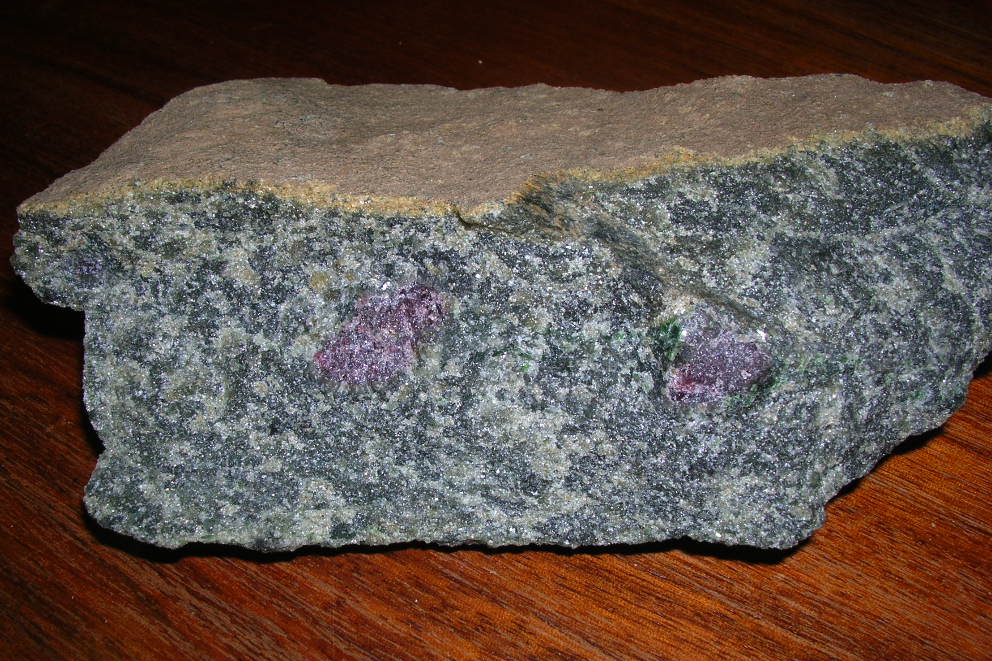
Coarser-grained ultramafic rocks are found in younger parts of the Earth’s crust, however. A coarse grained rock composed of olivine and pyroxene is known as peridotite from an alternative name (peridot) for the mineral olivine. There are a number of ways coarse-grained ultramafic rock can be formed.
Solid coarse-grained ultramafic rocks occur in the mantle, from which solid chunks are sometimes brought up to the surface in volcanoes (as mantle xenoliths) and as slices in mountain ranges called ophiolites.
Another relatively common way in which an ultramafic intrusive rock can form is if crystals of ferromagnesian minerals settle to the bottom of a body of mafic magma within the Earth and collect there, without feldspar, to make a solid ultramafic rock, described as cumulate rock. Sometimes cumulate rocks show distinct layers, similar to those found in sedimentary rocks. Once the ferro-magnesian grains have settled out, the residual magma is more silica-rich than before, so it produces igneous rocks that are more felsic than the original magma. This process is known as magma differentiation or fractional crystallization.
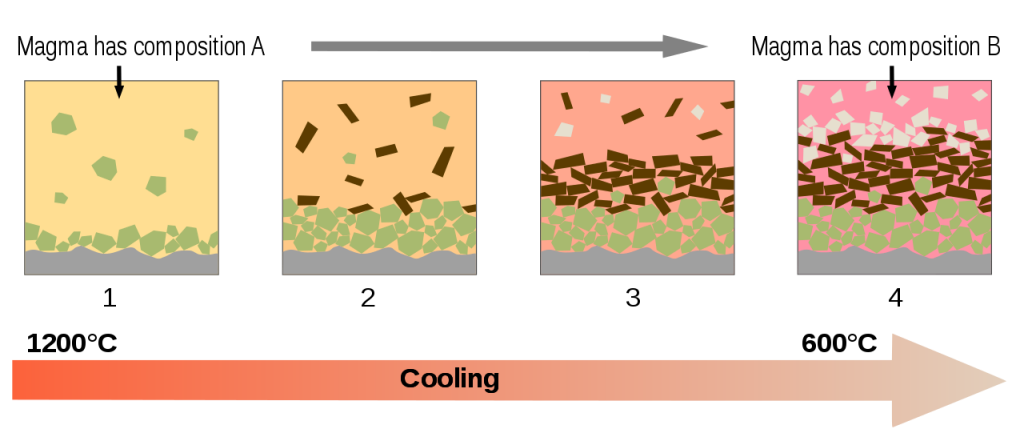
Finally, pyroclastic rock called kimberlite has ultramafic composition, and is believed to be produced by rare explosive eruptions directly from the mantle. It’s discussed in the next section.
Volatile components and tephra eruptions
In addition to the silica and other oxides listed in chemical analyses of rocks, most magmas contain dissolved water and other gases such as carbon dioxide. At depth, these volatile components are dissolved in the magma, but as magma rises toward the surface, the pressure decreases, and the volatiles are less soluble. These volatile components typically escape as a magma is erupted, but how they behave has an enormous influence on eruption style.
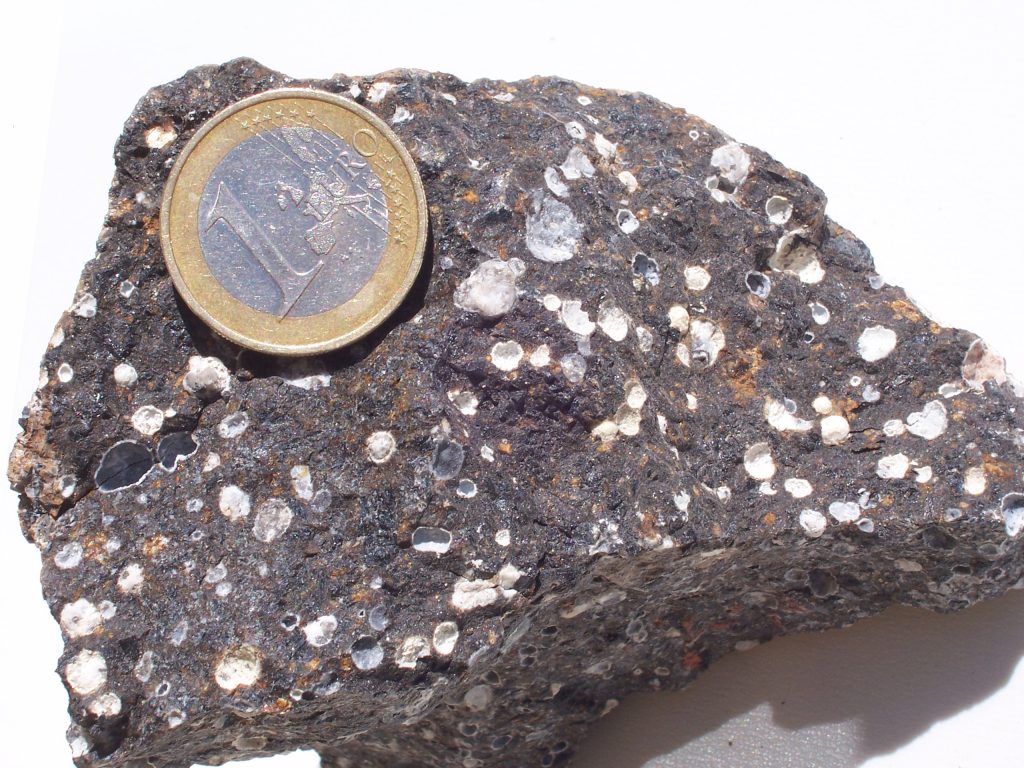
In a silica-poor, mafic magma, volatiles typically form bubbles in the magma as the magma approaches the Earth’s surface. These bubbles may escape quietly up to the surface, or they may cause fountaining of frothy magma, or they may be ‘frozen in’ when magma solidifies, forming vesicles. If the vesicles are more abundant than the solid rock, they produce a foamy textured rock called pumice. Some pumice will actually float on water. Sometimes vesicles are filled in later by minerals crystallizing from groundwater, producing small oval structures called amygdules[3].
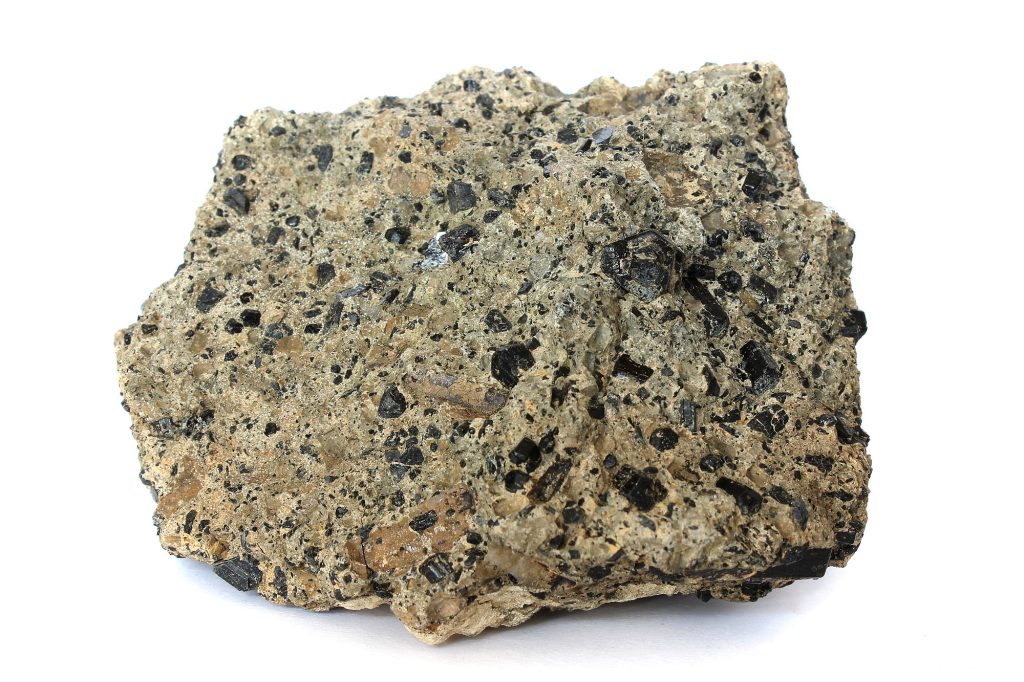
Silica-rich, felsic magmas are very viscous and the trapped volatiles cannot form bubbles easily. Sometimes, as silica-rich magma comes to the Earth’s surface, the gas escapes in catastrophic explosions. This is known as a pyroclastic eruption (from Greek words meaning “fire-broken”). The magma is shattered into glowing fragments which fall to the Earth as tephra. Tephra finer than 2 mm are called volcanic ash whereas larger fragments, up to 64 mm diameter, are called lapilli. Above that, larger fragments of lava thrown out by explosions are called volcanic bombs. Tephra that have solidified to make a solid pyroclastic rock are known as tuff.
Kimberlite is a special type of tuff which is known to have been generated directly from the mantle, as it has overall ultramafic composition. Kimberlite is found in conical kimberlite pipes hundreds of metres across that must have been produced by extremely rare violent eruptions sourced directly from the mantle. No kimberlite eruption has ever been observed, but kimberlite pipes are known in the crust of several continents, where they are the principal source of diamonds.
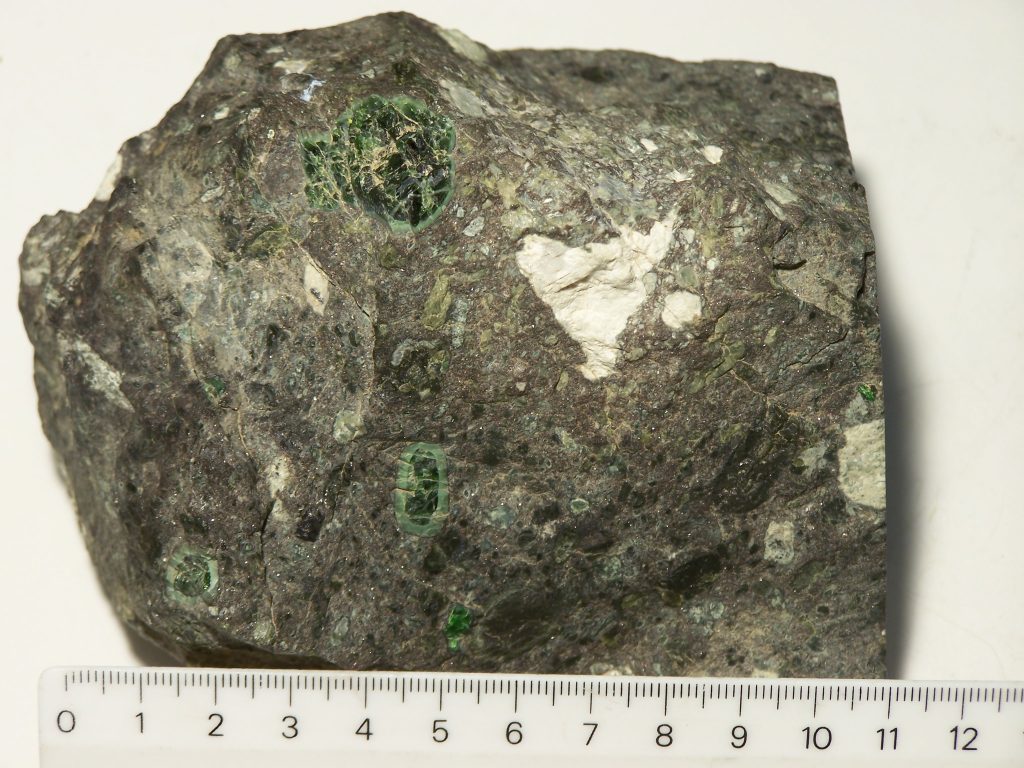
| Ultramafic | Mafic | Intermediate | Felsic | |
|---|---|---|---|---|
| Intrusive |
Peridotite |
Gabbro |
(Diorite and others) |
Granite |
| Extrusive | 
Komatiite |

Basalt |
(Andesite and others) |
Rhyolite |
| Glassy |  Obsidian Obsidian |
|||
| Fragmental | 
Kimberlite |
 Tuff Tuff |
||
Volcanoes

Volcanoes are places where magma reaches the surface of the Geosphere and is erupted as lava. A huge diversity of volcanic styles can be observed at the Earth’s surface. In many cases observations of modern volcanoes have helped with the interpretation of ancient igneous rocks in the Geosphere, an example of the principle of actualism.
Magma may rise through pipe-like channels called vents or through long cracks (fissure eruptions). The composition of the magma is a critical control on its behaviour as it reaches the Earth’s surface. Mafic magmas tend to produce quiet eruptions, whereas felsic magma is typically erupted in violent, dangerous explosions. As you might expect, intermediate magmas show both characteristics, depending on the amount of volatile material they contain.
Mafic volcanoes
On land
Because mafic magma has low viscosity (it is “runny”), volatile materials can form bubbles easily, allowing them to escape quietly from magma as pressure is released during its journey to the Earth’s surface. Mafic lava produces extensive and abundant liquid flows that can travel large distances over land from vents and fissure eruptions. The resulting shield volcanoes have gentle slopes between 2° and 10°. Above a vent, it is common for a roughly circular lava lake to form, within which convection can move slabs of solid lava around in a process that superficially resembles plate tectonics on the whole Earth.
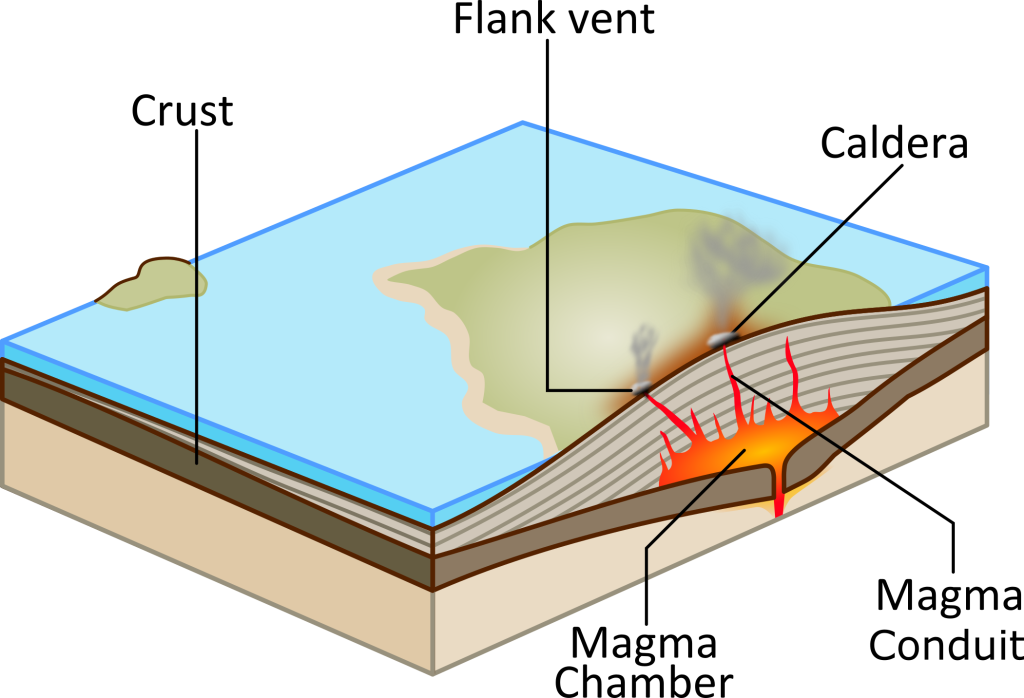
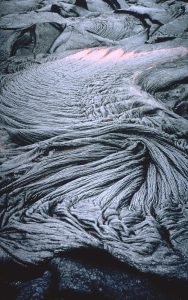
Lava flows at high temperature (above 1000°C) but mafic lava flows are relatively predictable once an eruption has started. Despite the speed with which they flow, deaths and injuries from mafic flows are rare. As high-temperature flows of mafic lava cool, they often form a solid but flexible skin over the surface which becomes wrinkled to produce a ropy structure known as pahoehoe from a word in Hawai’ian. Cooler, but still mobile flows produce a thicker solid crust that breaks up into a jagged blocks. These lava surfaces are called a'a, also in Hawai’an.

Mildly explosive activity does occur as gases escape from mafic magma, producing lava fountains cinder cones of tephra fragments called scoria.
Very thick lava flows may shrink as they cool, producing vertical cracks that extend downwards from the surface of the flow, and/or upwards from the base. These cracks tend to organize so that they outline columns that are hexagonal. Spectacular examples of columnar joints are known from ancient lava flows in many parts of the world.
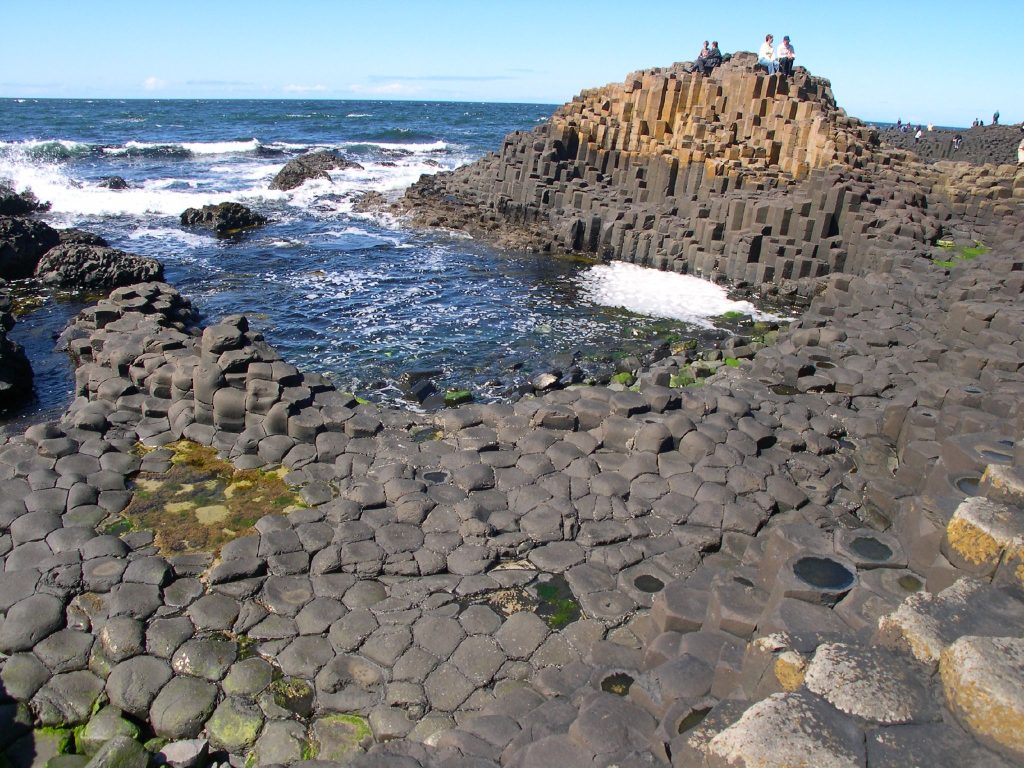
Under water
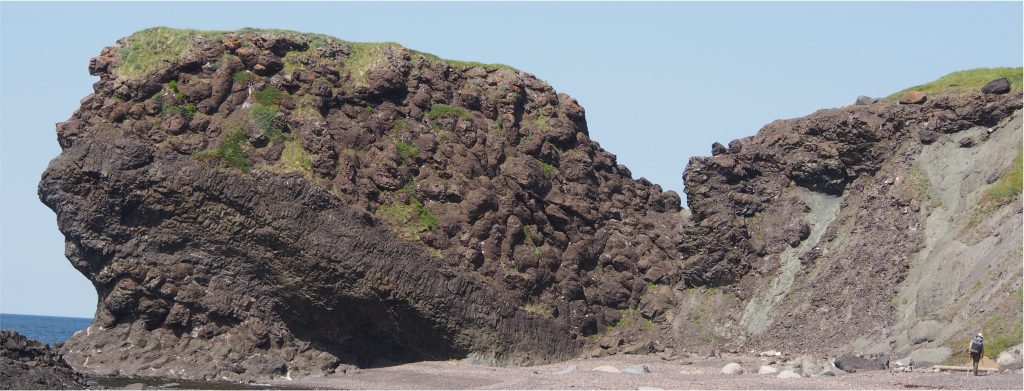

Mafic eruption styles are somewhat different under water. Because of the rapid chilling effect of water, mafic lava forms a flexible skin very fast, forming balloon-like bodies of lava which tumble onto the sea-floor to produce pillow lava. Ancient pillow lava is very recognizable in the rock record and is a good indication that eruption occurred under water.

 Felsic and intermediate volcanoes
Felsic and intermediate volcanoes
Intermediate and felsic magmas are much more explosive because the gases in the magma can’t escape easily by forming vesicles. When an eruption starts the pressure tends to be released as the first bit of magma is erupted, and that produces a cascading series of more and more violent explosions. Much of the magma may be turned into tephra.
Volcanoes that are produced by intermediate magmas typically combine the characteristics of mafic and felsic eruptions. They may be build from alternating layers of relatively viscous lava and tephra, forming composite volcanoes or stratovolcanoes with classic steep-sided conical shapes like Mount Fuji in Japan.
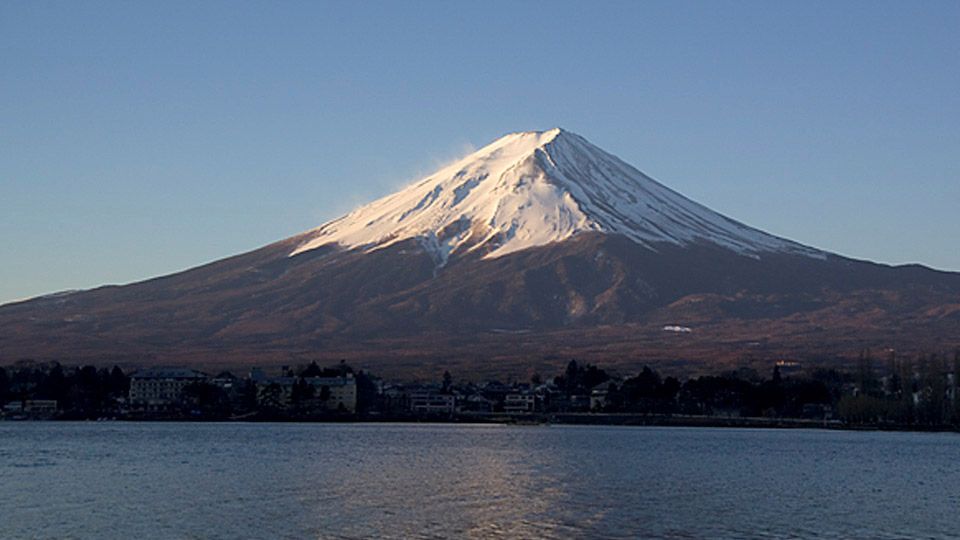
Volcanoes built of felsic lava are typically small lava domes up to a few hundred metres high, with steep sides produced by very viscous (stiff) lava. However, explosive eruptions are much more common in felsic volcanoes, so some lava domes exist within much larger edifices built largely of tephra.
Tephra eruptions are typically much more dangerous than lava. There is a variety of tephra eruption types. Eruption columns are ejected upward from a volcanic vent, sometimes expanding laterally high in the troposphere or extending into the stratosphere. Ash (fine-grained tephra) from a major volcanic eruption may fall hundreds of kilometres away from a central vent. Suspended ash in the atmosphere may spread around the world and affect climate by reflecting solar energy into space. When an explosion emerges off-centre it produces a lateral blast, sending tephra sideways to eventually fall on the landscape. The most dangerous volcanic eruptions of all are those which produce pyroclastic flows: glowing avalanches of mixed ash and hot gas that can travel at over 100 km/hr, burning or suffocating everything in their path. One such eruption in 1902 in the Carribean island of Martinique was responsible for the death of about 29,000 people in the city of St. Pierre. There were only four survivors. Another occurred from Mount Vesuvius in Italy, where it overwhelmed the city of Pompeii in year 79 CE. Excavations have revealed parts of the city, preserved within tuff deposits that buried the city and its inhabitants.
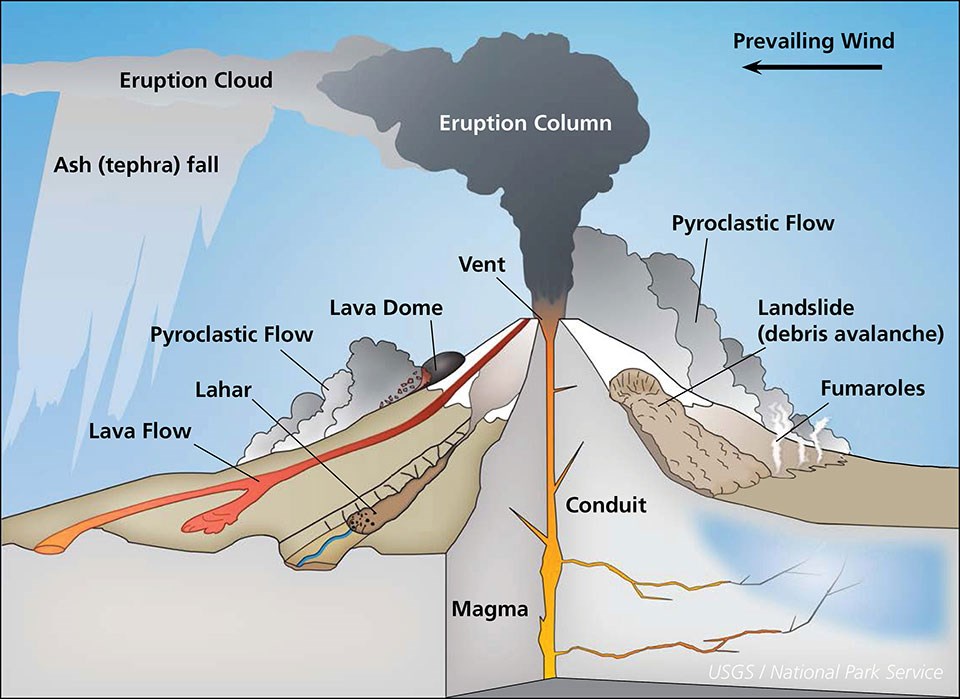
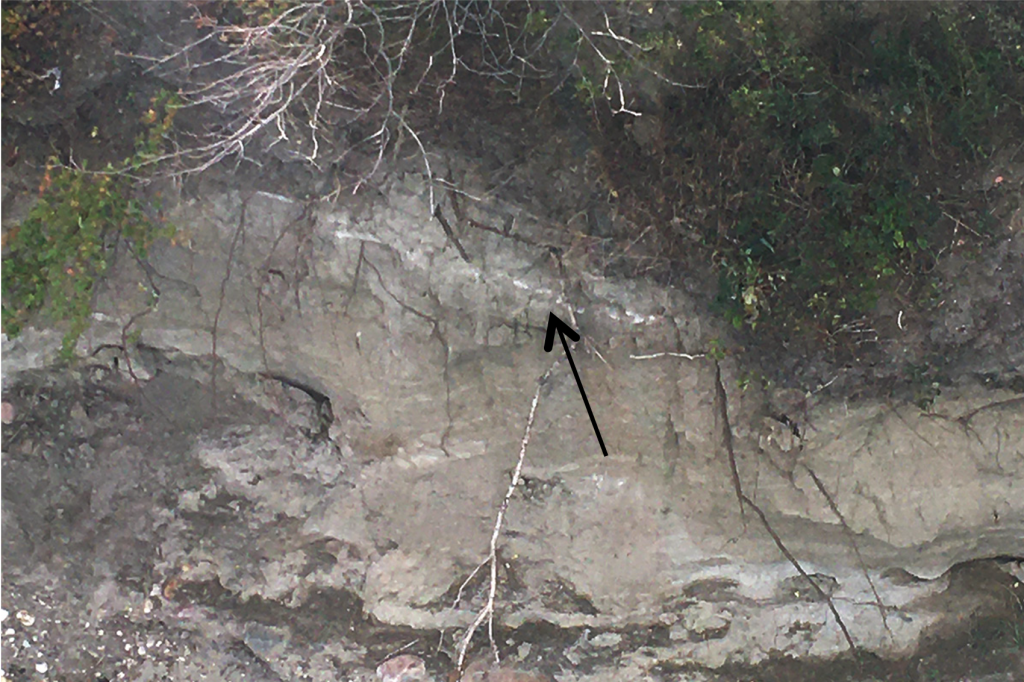
The biggest eruptions of all, known as caldera eruptions, can more or less destroy a volcanic cone. Crater Lake in Oregon, northwest USA, represents the remains of a volcano that has been named Mount Mazama, that was destroyed by a catastrophic eruption at approximately 8 ka (thousand years ago). Ash was spread all over the Pacific Northwest, reaching Edmonton AB, 1300 km away, as a distinct layer visible in sediment exposed in the valley of the North Saskatchewan River. The former volcano is now represented by an almost circular caldera (a broad crater in the landscape) about 8 km across, that is occupied by a lake. A small volcanic cone (Wizard Island) within the lake represents growth of the volcano since the major eruption.
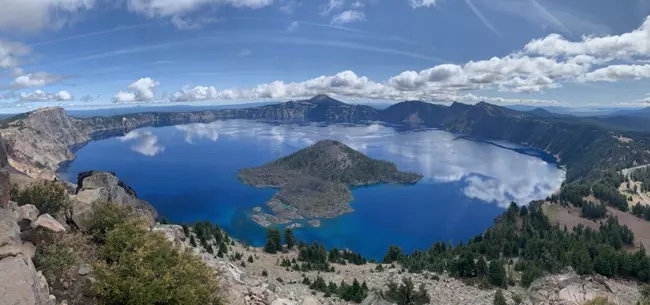
Similar catastrophic eruptions demolished volcanic cones in Thira (also known as Santorini) in the Mediterranean sea sometime between 1500 and 1650 BCE, and at Karakatau in Indonesia in 1883 CE.
Volcanic hazards
Volcanoes present multiple hazards to human populations, which are challenging to manage in volcanically active areas. Some of the principal hazards are as follows.
- Lava flows. Although lava flows are relatively easy to predict once an eruption has started, new volcanic activity from a previously dormant may present major threats, especially to property and buildings, in affected areas.
- Ash fall. Ash fall comes from tephra eruptions that spill ash into the atmosphere from vertical or lateral blasts. Suspended ash in the atmosphere is a major hazard to aircraft. Falling ash can obliterate crops, and the weight of ash may cause the collapse of building roofs. Inhaled volcanic ash may lead to respiratory illness, while the loss of crops and livestock may lead to famine in human populations in affected areas.
- Pyroclastic flows are masses of tephra and gas that move down slopes under the force of gravity, reaching speeds up to 700 km/hr. They are perhaps the most violently deadly of volcanic hazards.
- Lahars are volcanic mudlflows which may be hot. Most typically they originate when an eruption spills water or melts ice from the upper regions of a volcano. However, an eruption is not necessary; ice and snow may be melted even by the warming of a volcano. The death tolls from lahar events have approached those from pyroclastic flows.
- Tsunami waves (covered in more detail in the section on earthquakes) may be generated by volcanoes. The 1883 eruption of Krakatau generated a tsunami that killed about 36,500 people.
- Volcanic gases may sometimes be ejected without warning and may displace oxygen. Release of carbon dioxide from volcanic Lake Nyos in 1984 led to the suffocation of ~1700 people.
- Climate effects are well documented after large eruptions, which suspend ash and sulfur dioxide in the atmosphere, acting to reflect solar energy. The eruption of Mt. Pinatubo in the Philippines in 1991 led to a measurable drop in global temperature of about 0.6°C lasting 2–3 years. Earlier, much larger eruptions of Krakatau in 1883 and Tambora in 1815 were followed by particularly cold years worldwide, associated with widespread crop failures and famine.
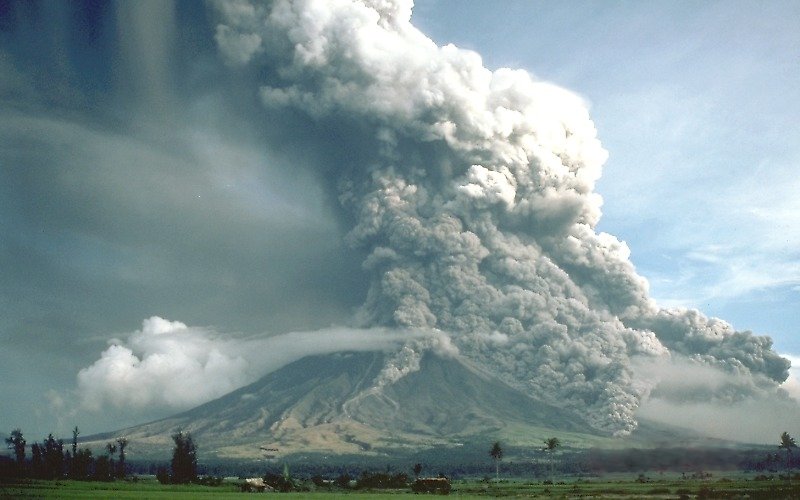
- Rocks are typically analysed either by mass spectrometry, in which individual atoms are weighed and counted by firing them through electric and magnetic fields in a vaccuum, or by x-ray fluorescence, in which an electron beam is fired at a sample, and the frequencies of x-rays given off are measured. ↵
- spelled dikes in the United States ↵
- Amygdales in British English ↵
A naturally occurring mixture of minerals, and in some cases other solid materials, that occurs in the Geosphere
Relating to or formed from molten rock.
Rock deposited on the surface of the Geosphere by the action of the Atmosphere, Hydrosphere or Biosphere, formed from the products of the weathering and erosion of older rock
Rocks that have recrystallized while solid, as a result or heat, pressure, and/or deformation
Molten rock
Magma (molten rock) that has emerged onto the surface of the Earth.
Rock fragments generated by volcanic eruptions
The layer within the Earth or other inner planet that overlies the core and makes up the majority of the planet, composed chiefly of magnesium- and iron-rich silicates
Deformation where strain and stress are proportional. Energy is then stored in elastically deformed rocks and released when the stress is reduced.
Describes liquids with high ability to resist flow
A change to a system is adiabatic no heat energy is gained or lost during the change
A substance containing covalently bonded silicon and oxygen groups in its atomic structure
A graphical representation showing the conditions of temperature, pressure, or composition in which different phases are stable
Silicate minerals that contain large amounts of magnesium and/or iron, typically in solid solution, and a relatively low amount of silica.
Places where magma reaches the Geosphere surface.
A convergent plate boundary where one plate descends beneath another.
A boundary on a phase diagram separating fully solid material from material with some liquid; the start of melting.
A boundary on a phase diagram separating fully liquid material from material with some solid components, marking the completion of melting.
Rock material that is a mixture of solid and liquid
A silicate of iron and/or magnesium with separate silicate tetrahedra in its structure; (Mg,Fe)₂SiO₄.
A thin, surface layer of the Earth that lies above the Moho; differentiated into thicker, lighter continental crust and thinner, denser oceanic crust
Melting of rock material to produce a mixture of solid and liquid.
Silicate Tetrahedron (Also silica tetrahedron or SiO₄ tetrahedron; plural tetrahedra): A group of four oxygen atoms covalently bonded to a silicon atom; the basic building block of silicate minerals.
Silicon dioxide SiO₂
Silica SiO₂ in its most common mineral form.
An abundant group of framework silicates containing aluminum together with some combination of
potassium, sodium and calcium
A group of sheet-silicate minerals with a sheet-like habit and perfect cleavage.
Bodies of igneous rock formed when magma solidifies within the Geosphere.
Describes igneous rock formed from magma that cooled at the Earth’s surface; volcanic.
Relating to volcanoes: places where magma reaches the surface of the Geosphere as lava
Igneous rock formed by rapid cooling of lava, such that crystal lattices are unable to form; rock with the structure of a supercooled liquid.
The sizes, shapes, and relationships between the mineral grains that make up a rock.
The removal of material from a site of weathering on the Earth's surface.
Large igneous intrusions
Sheet-like igneous intrusions are concordant with layers in their host rock
Having a parallel orientiation to adjacent rock structures.
Dyke (USA — dike): A sheet-like igneous intrusion that is not concordant with any layering in its host rock
Geological features that are not parallel to one another
Igneous rock formed when magma solidifies within the Geosphere.
The rock units into which magma intrudes.
The edge of an igneous intrusion where rapid cooling due to contact with cold host rock
produces finer-grained rock than is found in the interior of the intrusion.
Fragments of host rocks that are embedded within an igneous intrusion.
Igneous rock or magma with more than about 65% silica. Felsic rocks typically contain quartz
with potassium and/or sodium feldspar.
Of silicate minerals and rocks, having large amounts of magnesium and iron; mafic rocks have silica contents of 45–50%.
Coarse-grained felsic igneous rock containing quartz and potassium feldspar.
A hard extrusive felsic igneous rock, the fine-grained equivalent of granite.
An igneous rock or magma with between 52% and 65% silica
The plate tectonic process whereby one plate descends beneath another as plates converge
A measure of the resistance of a fluid to shearing; measured as the force concentration needed to achieve a given velocity gradient. In everyday terms, a measure of hhow 'thick' a fluid is.
The extrusive product of mafic magma. Basalt has a fine grain-size and a dark colour.
Intrusive mafic igneous rock.
A group of mainly ferromagnesian single-chain silicate minerals common in mafic rocks
Magma or igneous rock with a silica content of less than 45%
An eon early in Earth history prior to the Proterozoic from ~4 Ga to 2.5 Ga
Extrusive ultramafic volcanic rock.
Utramafic rock composed mostly of pyroxene, usually together with olivine
Gem-quality olivine
Sections of mafic or ultramafic rock from oceanic lithosphere that have been uplifted on land.
Intrusive rock in which minerals that formed early have sunk and accumulated at the bottom of a magma chamber
Changes in the composition of magma due to the removal of certain chemical components, often as a result of mineral settling.
Describes products of explosive volcanic eruptions that produce rock fragments.
Ultramafic tuff produced by explosive volcanic eruptions sourced from the mantle; the main source of diamonds.
Dissolved water and gas in magma, or the behaviour of such material
Rounded cavities in igneous rock formed by gas bubbles in the magma.
A vesicles in an igneous rock such as pumice that has been infilled with minerals
Fine-grained tephra less than 2 mm in diameter.
Large fragments of tephra 2 to 64 mm in diameter.
Volcanic fragments larger than 64 mm in diameter that are released in explosive eruptions.
Solid pyroclastic rock formed from lithified tephra.
Large cylindrical structures preserving ultramafic tephra sourced from the mantle; the main source of diamond.
A crystalline mineral form of elemental carbon the hardest known mineral.
The principle that events in the past can be explained in terms of physical, chemical, or biological processes and laws that operate at the present day
Pipe-like channels up which magma may flow.
The eruption of magma as lava through cracks in the crust.
Movement of fluid material along the surface of the Earth.
Gently-sloping volcanoes formed by mafic lava flows that travel over long distances.
A body of liquid lava ponded in the crater or caldera of a volcano.
A theory that the Earth has a lithosphere that is divided into relatively rigid moving plates that interact along plate boundaries
A ropy lava surface formed when high-temperature flows of mafic lava cool.
A small, steep volcano composed of loose tephra fragments known as scoria
Porous, highly vesicular rock derived from lava; may form on the surface of a lava flow, or during its pyroclastic disruption.
Hexagonal structures formed due to cracks in thick lava flows that have shrunk during cooling.
Masses of mafic rock formed when mafic lava in the ocean rapidly cools by contact with water, forming balloon-like bodies.
A typically conical volcano consisting of layers of both tephra and lava; stratovolcano.
Conical volcanoes consisting of alternating layers of lava and tephra, typical of intermediate magma compositions.
Small, steep-sided volcanoes typically formed by felsic lava.
Vertical eruptions of tephra from a volcanic vent, which may further expand in the atmosphere
Volcanic explosion that expels tephra in a near-horizontal direction.
Fluid mixtures of tephra and hot gas that quickly travel down the flank of a volcano
Highly explosive eruption that largely collapses a conical volcano leaving a broad circular crater
A broad crater with a rim that is low in relation to the crater diameter
Near vertical descent of ash from the atmosphere to the surface of the Earth.
A debris flow generated by volcanic activity
A wave on the ocean surface resulting from an earthquake, volcanic eruption or a landslide.
Long-term trends in Earth’s atmosphere which may affect weather, but take effect for much longer. Climate is weather averaged over periods longer than a single year

